| The KLÜSSENDORF ATM vending machines in Spain |

|
After the experiences with the Frama vending machines, and trailing other postal administrations worldwide in the same period, Spain's Correos y Telégrafos acquired 16 machines in 1992 from the German company Klüssendorf AG for the supply of variable value stamps or ATMs consisting of 14 StampCenter 631 ATM vending machines and 2 Stampcenter 847 counter / table stamp printer machines. |
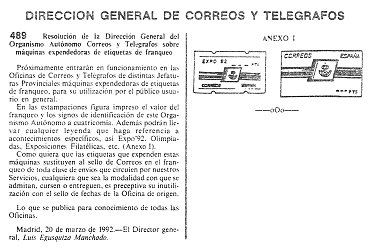 |
We can find the start of this new phase in the postal history of Spain in Resolution nr. 489 of the Dirección general del Organismo Autónomo Correos y Telégrafos, dated March 20th 1992, and published in the Boletín oficial de Comunicaciones nr. 25, of March 27th 1992.
Although the Resolution talks only about the Klüssendorf vending machines and its issues, in the annex there appears a picture of the first design issued by the Epelsa franking balances. |
The StampCenter 631 machines were for public use, and were of an upright construction. On the right hand side it had 20 buttons which could be programmed with different basic franking values (see tables) or functions, and a yellow one in the lower part to issue a receipt for the transaction.
Following very simple instructions and referring to the postal rates shown in the left panel, the user could select a value, pay the corresponding amount with coins, and the machine would automatically issue the corresponding variable rate stamp or ATM, as well as the change in coins. It was possible to obtain up to a maximum of 10 stamps in one operation.
These machines were acquired initially to offer a service for visitors to the different cultural and sports events held in 1992 in Spain. 12 of the distributors were, in April 1992, installed in the Expo '92 World's Fair in Seville, and the other 2 in the Granada 92 World Philatelic Exhibition and later in Barcelona on the occasion of the Olympic Games.
Once these large events were finished, the 14 vending machines (numbers 001 to 014) were, from October 1992, installed permanently in the main post offices of the 12 provincial capitals; La Coruña (001), Zaragoza (002), Alicante (003), Madrid (004 and 014), Bilbao (005), Valencia (006), Seville (007), Palma de Mallorca (008), Oviedo (009), Valladolid (010), Barcelona (011 and 012) and Málaga (013).
All the Stampcenter 631 distributors issued ATMs with a 3 digits face value, starting from 17 up to 999 pts. |
 |
| ATM vending machine StampCenter 631 in Germany |
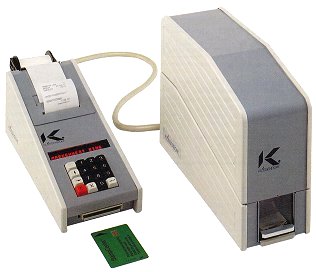 |
In addition to the 14 self-service machines, Correos also acquired 2 Stampcenter 847 table top stamp printers, used only by employees of the Philatelic Service in the temporary post offices of some philatelic events (Granada 92 and the Barcelona 92 Olymphilex), and later for philatelic orders.
These machines could issue ATMs with any face value from 17 pts, as well as receipts for the operations. The number of the machine (1 or 11) could be printed on the receipts. |
The Stampcenter 847 stamp printers were initially set up to issue 4-digit ATMs, but they were ‘adapted’ (by filing down one of the characters on the wheel of digits) to issue 3-digit stamps, identical to this ones issued by the Stampcenter 631 distributors.
As it happened, the Philatelic Service already had begun - by error- to supply 4-digit ATMs, so they finally decided that one of the 847 machines would issue 3-digit ATMs and the other, 4-digits.
| The ATMs 'type Klüssendorf' |
For the issue of ATMs, the Klüssendorf machines used rolls of gummed, pre-printed labels 43 mm wide, with different designs.
The feed mechanism is by roller traction of the labels which includes two circular holes, and each printed label includes two semicircles at the top and two in the lower part.
The printing of the face value on the ATMs was mechanical, with black ink (*), using a print head with 4 wheels of digits.
Once cut and issued by the machine, the stamp size was 43 x 25.50 mm.
(* There exists rare Klüssendorf type ATMs with red and blue-violet imprint, issued from 1997 by postal self-services IBM. Read article).
|
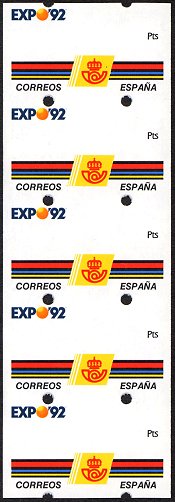 |
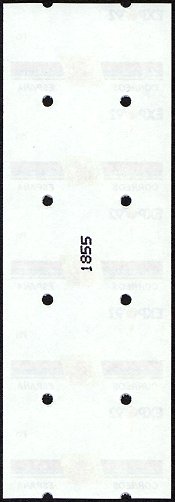 |
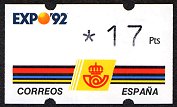 |
As can be seen in the strip of labels (upper image), every fifth ATMs has a control number on the back that indicates the number of stamps that remain in the machine.
As the full coils have 2,000 labels, the first number delivered is 2000 and last one, 0005. From a collecting aspect, ATMs with these 2 numbers are rare as the 2000 could be lost in a new roll loading process, and on many occasions the machine did not run through to the last few labels in the normal printing and issuing process. |
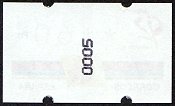 |
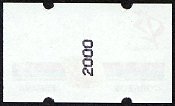 |
The face value in the ATMs was printed with 3 or 4 digits depending on the machine used. If the ATMs were printed with a Stampcenter 631, the printing always had 3-digits. If the ATMs were printed with a StampCenter 847 the printing could be either 3 or 4 digits, depending on the configuration of the machine. For this reason ATMs exists with both printing varieties for all the Klüssendorf issues.
Other machines and prototypes later used the same type of labels for the issue of ATMs. There also exists a special printing variety of 3 or 4 digits issued by a INESC prototype; its printing can easily be recognized because it was made with an 8-pin printer. This section studies only the Klüssendorf machines, the rest of equipment is studied in other articles.
ATM Web - Spain and Latin American Postal Services: http://www.ateeme.net
© J. Jove - M. Sans. ATEEME. Variable value stamps study group. All rights reserved
This page was created in 1999 and last updated:
09.07.07
. English edition rewritten by S. Goodman (07.07.07) |











